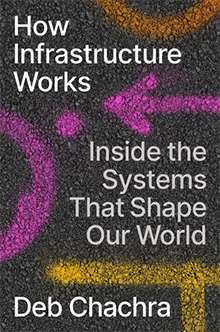 Subtitled Inside the Systems That Shape Our World this is a superb book, potentially life-changing at every level, from the most individual to the largest big scene imaginable.
Subtitled Inside the Systems That Shape Our World this is a superb book, potentially life-changing at every level, from the most individual to the largest big scene imaginable.
Deb Chachra is a professor at Olin College of Engineering in Boston, with a technical background in engineering physics and materials science. Her aim in this book is initially to draw attention to the visible and invisible infrastructure that underpins the world, from the bridges, roads and buildings we can see to the the power, plumbing, and communications networks we can’t see, all of which we take for granted and on which we all depend, wherever we live in the world.
Chachra is perhaps uniquely qualified to discuss this, not only because of her professional qualifications, but because she has lived, worked, studied and taught in India, Canada, the UK, and the USA. She brings a lively personal awareness of social issues to what could be a very dry subject.
Best of all, her writing sparkles: she’s well-informed, articulate, witty and writes very much from her direct interaction with everything from sewerage to power stations.
What’s especially attractive about this book is that it’s not just a historical account of how societal infrastructure developed, or even why it developed the way it did – although Chachra does cover that in fascinating detail.
She goes further, to place our existing infrastructure into a future context that has to take into account climate change, population growth, limited resources, and increasing physical development across the world.
Somehow, she comes out of this with a message of hope, by which I mean not just an airy-fairy wish list but a clear, practical plan that puts the emphasis on designing, resourcing and building a better world, one that acknowledges that things need to change, and can.
Her scope is huge, and her ability to think about our world in different ways is inspiring. For example, rather than thinking in terms of reducing personal carbon footprints (a canard foisted on us by fossil fuel companies) thinking in terms of collectively increased use of sun, wind and solar to create an electrically driven world.
It’s rare to encounter someone who has such a firm grasp of the context of engineering infrastructure from the minute details of daily life to global development, and who can communicate her ideas so clearly, with such delight in her subject matter.
You can read some extracts of the book online in this Guardian article and this Comment magazine article.
Highly recommended.